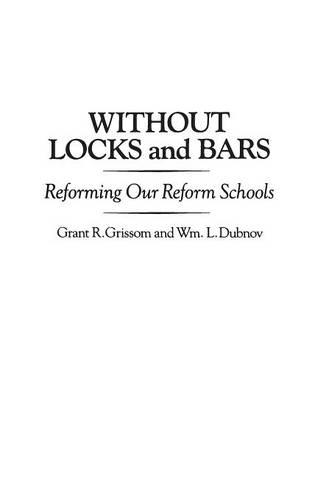
Without Locks and Bars: Reforming Our Reform Schools
(Hardback)
Publishing Details
Without Locks and Bars: Reforming Our Reform Schools
By (Author) Grant R. Grissom
By (author) William L. Dubnov
Bloomsbury Publishing PLC
Praeger Publishers Inc
7th August 1989
United States
Classifications
Tertiary Education
Non Fiction
365.974814
Physical Properties
Hardback
268
Width 156mm, Height 235mm
624g
Description
A pioneering contribution to the field of juvenile corrections and organizational development, this volume documents the organizational change process which transformed Glen Mills Schools, America's oldest juvenile correctional institution, from a physically deteriorating, ineffective institution into one of the most successful residential programs for delinquents in the nation. Of particular interest to practitioners, policymakers, researchers and students of juvenile justice, the volume provides both a theoretical model and practical guidelines for the effective reform of juvenile facilities. Documentation of Glen Mills' success includes the most extensive recidivism study ever conducted on an American correctional institution. Without Locks and Bars demonstrates that the normative culture residential treatment approach for juvenile offenders can and does work at costs below most traditional programs. The authors describe the theory, beliefs, and values which underlie the formal treatment system at the Glen Mills Schools and the process through which the psychosocial environment (normative culture) is shaped into a potent treatment tool. Especially helpful for practitioners at similar facilities is a detailed discussion of the major steps that must be taken to replicate the Glen Mills model. Based upon the observed effects of the Glen Mills experience, the authors challenge some widely held assumptions in the field. They conclude that most delinquents have far greater potential for positive behavioral change and educational achievement than is generally believed; that most, including serious and repeat offenders, can be treated in an institution where physical security is not necessary and that, if properly managed, large residential facilities may be the placement of choice for most institutionalized delinquent offenders.
Reviews
. . . The book should be carefully read by juvenile justice system professionals, by those involved in juvenile justice policy development, and by citizens concerned about the relationship between our society and the frightening number of youngsters who have been so badly hurt in their early years and who, as a result, have become so hurtful of the security of the streets and neighborhoods of the world in which they must live.-Social Service Review
A creditable addition to the literature pertinent to juvenile corrections. Although the book focuses on a specific institution in Pennsylvania, there is a sufficient amount of attention given to the application of the programmatic and philosophical changes to similar institutional environments elsewhere. Both authors have been associated with changes at the Glen Mills Schools for a number of years, hence the validity of what has been included. The book provides both a model and practical guidelines that could be implemented within other juvenile correctional facilities. The publication is organized chronologically, beginning with events that led to the need for change, then moving to how change actually occurred, and ending with the results of the new focus. The chapter on evaluation provides a convincing argument for similar changes in state reform schools. One other publication that addresses the reform of juvenile corrections is Robert B. Coates's Diversity in a Youth Correctional System: Handling Delinquents in Massachusetts. Extensive bibliography, general and name indexes, and a useful appendix, Glen Mills Norms.' Most useful for graduate students, policymakers, and juvenile correctional administrators.-Choice
." . . The book should be carefully read by juvenile justice system professionals, by those involved in juvenile justice policy development, and by citizens concerned about the relationship between our society and the frightening number of youngsters who have been so badly hurt in their early years and who, as a result, have become so hurtful of the security of the streets and neighborhoods of the world in which they must live."-Social Service Review
"A creditable addition to the literature pertinent to juvenile corrections. Although the book focuses on a specific institution in Pennsylvania, there is a sufficient amount of attention given to the application of the programmatic and philosophical changes to similar institutional environments elsewhere. Both authors have been associated with changes at the Glen Mills Schools for a number of years, hence the validity of what has been included. The book provides both a model and practical guidelines that could be implemented within other juvenile correctional facilities. The publication is organized chronologically, beginning with events that led to the need for change, then moving to how change actually occurred, and ending with the results of the new focus. The chapter on evaluation provides a convincing argument for similar changes in state reform schools. One other publication that addresses the reform of juvenile corrections is Robert B. Coates's Diversity in a Youth Correctional System: Handling Delinquents in Massachusetts. Extensive bibliography, general and name indexes, and a useful appendix, Glen Mills Norms.' Most useful for graduate students, policymakers, and juvenile correctional administrators."-Choice
Author Bio
GRANT R. GRISSOM is Vice President of Research and Development at Integra, Inc. where he has conducted a broad range of organizational research projects. Wm. L. DUBNOV is a Psychologist and has been a Research Associate at the Glen Mills School for Boys.
